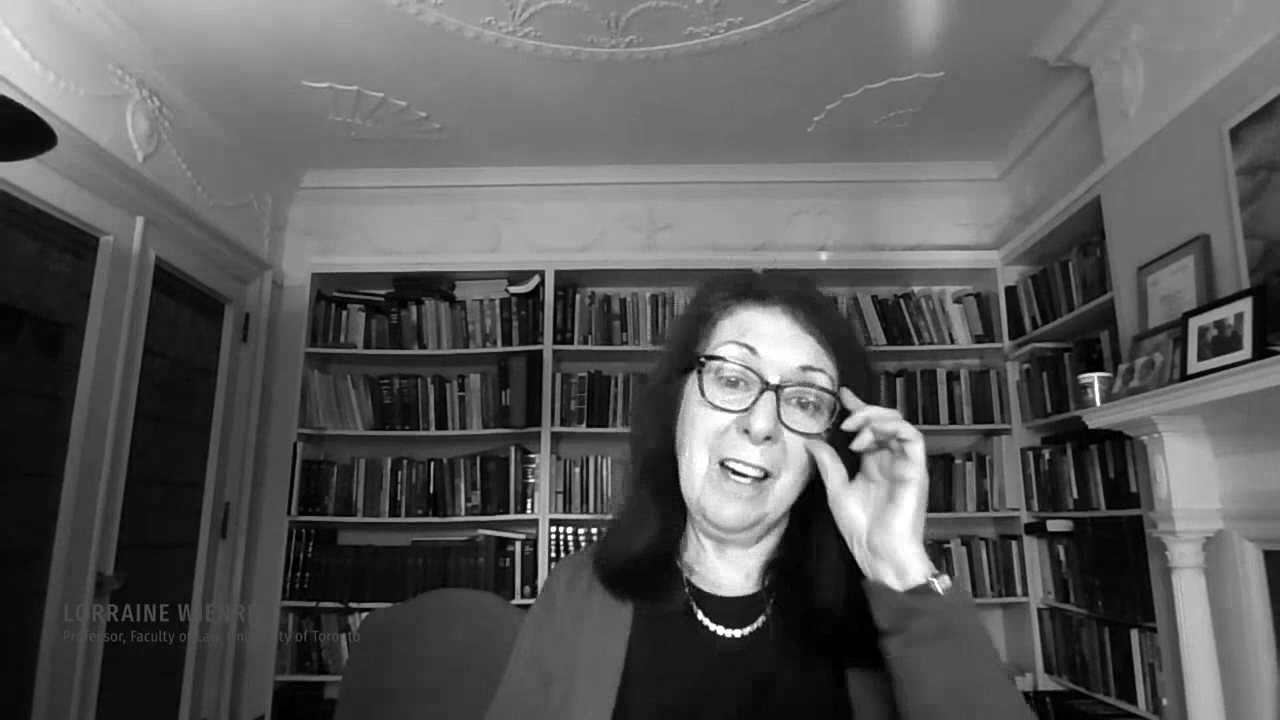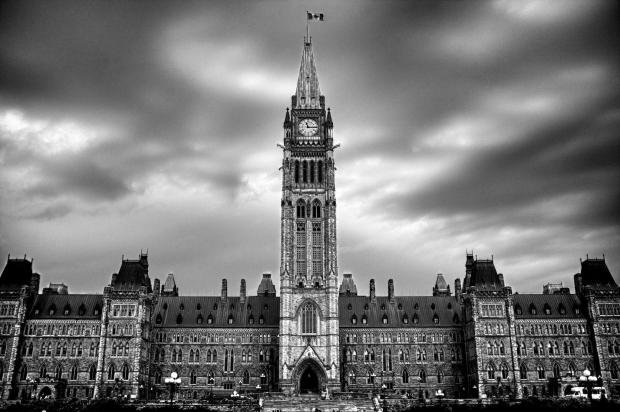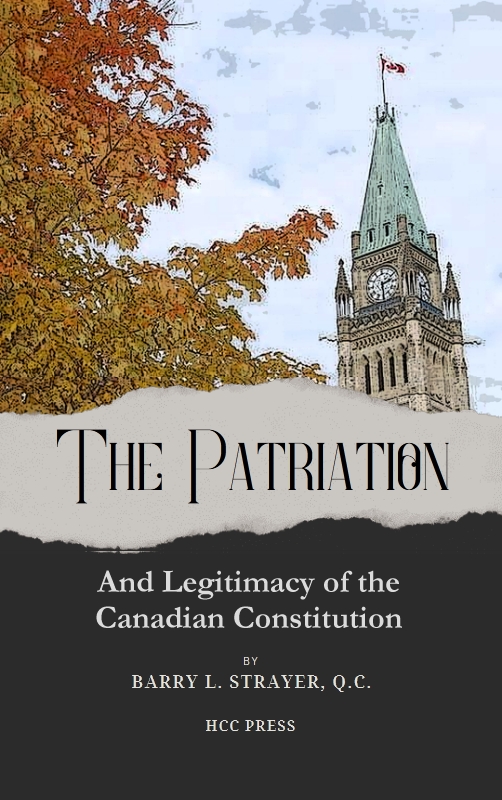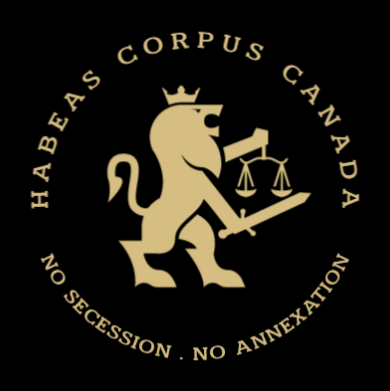
Lorraine E. Weinrib
War on Canada! Law professor Weinrib (ex-Ontario Justice Department) likens the 1982 “patriation” to a “defeat in war”
The existence of a coup recognized by Strayer himself, its principal architect, is corroborated in many places. Law professor Lorraine Weinrib, for example, while trying to conceal the coup in which she, too, played a role, had the misfortune to describe the fraudulent “patriation” of 1982 as tantamount to a “defeat in war” for Canada. A constitutional amendment is neither a “trauma”, as Barry Strayer puts it, nor a “defeat in war”. However, a “defeat in war” destroys the constitution of the losing power, which is then replaced by a constitution chosen by the victor.
In her guest lecture entitled “Justifying Oakes” for the Symposium at the Ottawa Law Review (“The Past, Present and Future of Section 1 of the Canadian Charter of Rights and Freedoms”) on February 9, 2012,1 constitutional law professor Lorraine E. Weinrib’s technique for covering up the 1982 coup on Canada — and her own role in it for the Ontario government — is to praise and extol every one of its unconstitutional, illegal, and anti-democratic aspects as though each were constitutional, legal, and democratic.
But “democratic” would have to mean the Canadian people had voted for the overthrow of their own institutions. However, they were not even asked to vote; no doubt because it was illegal to ask. More to the point, had they been asked, they would have said, “No”. Which would have been unacceptable to those who had “dissatisfaction” as we will see below. Therefore, a coup was imposed.
The 1982 coup d’état on Canada, hidden behind the fraud of an alleged “constitutional amendment”, and that fraud itself hidden behind the fraud of “substantial consent”, was therefore not a “popular” revolution.
The Epitome of Euphemism

Canada’s Parliament Buildings
Weinrib calls the coup on Parliament “an amazing transition”; a “dramatic” constitutional change; one that came about because “we” she says, “had dissatisfaction” with “institutions” (here comes the dead give-away) “that we couldn’t change”.
“We” does not mean the Canadian people. “We” means those who hijacked the country. By “institutions”, Weinrib means the British-style Parliament and provincial Legislatures of the founders of the national homeland of Canada.
The Westminster Parliament and legislatures of 1867 are permanent, which is why “they” (the conspirators) couldn’t “change” them. And “changing” them (i.e., replacing them) was not a “constitutional amendment” but a constitutional and parliamentary coup d’état. The 1982 “Charter” threw down the Parliament of Canada. In its wake, Provincial Legislatures from sea to sea reeled under the blow — before they toppled and were swept out to sea.
In the wake of the coup d’état, a tsunami was unleashed that is still sweeping the world today, engulfing it under wave after wave of “coup d’état” constitutions, using poor “defeated” Canada as a “model”.
Weinrib characterizes the criminal conspiracy among the Trudeau regime and the premiers of the provinces who organized the coup as “a rich debate”. Weinrib speaks on what the 1982 “Charter” (the coup d’état) really did to Canada when “added” to Confederation (the political and legal structures of 1867).
In “Canada’s Charter of Rights: Paradigm Lost?“, 119-178, Review of Constitutional Studies, Vol. 6, No. 2, 2002, at page 120, Weinrib writes:
“First, the adoption of Canada’s Charter of Rights and Freedoms occurred without the precipitating events that have pushed other nations to this step, such as revolution, defeat in war, or reconstruction of government at the end of a regime …”
Those are indeed the words of a “law” Professor: Lorraine Eisenstadt Weinrib, a constitutional adviser to the government of Ontario at the time of the patriation coup d’état.

Canada’s Constitutional Revolution, Barry Lee Strayer
What is “revolution”? My WordWeb dictionary from Princeton gives three clear meanings:
1. A drastic and far-reaching change in ways of thinking and behaving
2. The overthrow of a government by those who are governed
3. A single complete turn (axial or orbital).
The Founding Peoples of Canada did not overthrow their government in 1982, any more than the Russians overthrew theirs in 1917.
In her 2007 article, “‘This New Democracy …’: Justice Iacobucci and Canada’s Rights Revolution” for The University of Toronto Law Journal, Vol. 57, No. 2, Education, Administration, and Justice: Essays in Honour of Frank Iacobucci (Spring, 2007), pp. 399-413, at 403, Weinrib chants the litany again:
“It is nonetheless challenging for any legal system to make the transition from legislative to constitutional, rights-based democracy. This is particularly the case for a country like Canada, where the transition was not precipitated by a convulsive experience, such as regime change, the demise of a failed state, or defeat in world war. Such convulsive experiences repudiate what came before, often signalling the need for new comprehensive constitutions and new institutions to give them life.”
Madam is implying that in Canada, the British North Americans, the founding peoples of Canada, “repudiated” their own history and overthrew their own Parliament in 1982.
The irony here is that Weinrib denies the 1982 Charter coup arrived with “regime change”. In fact, we had full-blown “regime change” in Canada on the Southern-Rhodesian model when Marxist Mr. Trudeau hung onto an office he did not legally hold due to his void oath, and imposed the “new constitution”.
Notice that Barry Lee Strayer, in his Cronkite Lecture No. 1 at page 3-4, refers both to Ian Smith’s coup on Southern Rhodesia and the American coup of 1776, neither of which were “constitutional amendments”, but to both of which Mr. Strayer compares the so-called patriation of 1982.
Weinrib’s tone further coheres with the tone of Strayer. At page 3-2 of his 1982 Lectures, Strayer declares:
“During the last two years, this country has gone through a constitutional trauma …”.
Constitutional amendment is not trauma. More graphically, according to Weinrib, the Charter’s imposition was similar to the fate of a nation after a defeat in war. And, says Weinrib, by necessary implication, the Charter reconstructed government … at the end of a regime.
Footnote
1. A video of the lecture was put online in YouTube as “Situating Section 1: A Framework for Thought”, uOttawa, Faculty of Law, Common Law Section, Published on April 30, 2012. The full length was 40 minutes and 6 seconds.

